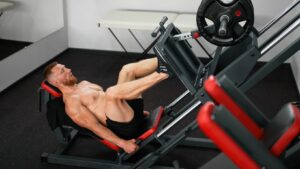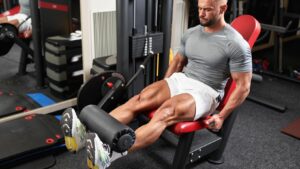When it comes to building powerful, well-defined legs, there’s no shortcut. It’s all about consistency, hard work, and the right hypertrophy leg workout. If you’re ready to step up your fitness game, you’re in the right place.
Understanding Hypertrophy
To discuss hypertrophy leg workouts, it’s crucial for us to delve into an understanding of hypertrophy itself. Hypertrophy refers to the process where muscle fibers endure micro-tears due to strenuous, weight-bearing exercises. These micro-tears, once healed, aid in enlarging muscle size.
Firstly, workout intensity ties directly to muscle growth. It’s a delicate balance as lifting extraordinarily heavy weights may lead to injury, whereas light weights might not be effective for gaining muscle mass. Typically, performing 6-12 reps of a particular exercise at 75-85% of your one-repetition maximum (1RM) proves beneficial for hypertrophy.
Secondly, recovery time is a vital factor when aiming at hypertrophy. While working out, stress forms in our muscles causing micro-tears. During recovery, the body repairs these tears, leading to muscle growth. To facilitate optimal recovery, a break of 48-72 hours between intensive leg workouts is often deemed necessary.
Finally, a balanced diet rich in high-quality proteins, complex carbohydrates, and healthy fats assists in the repair and growth of muscles post a hypertrophy workout. For instance, consuming nutrient-dense foods like lean meats, eggs, whole grains, and healthy fats like avocados forms a necessary part of a hypertrophy-focused diet.
Hypertrophy leg workout
Creating hypertrophy leg workouts revolves around three main principles. Select compound leg exercises, plan targeted sets and repetitions, and maintain a progressive overload strategy. Each principle plays a significant role in delivering the desired results, muscle growth, and strength.
Firstly, choose compound leg exercises – powerful movements that work multiple muscles at once. Squats, deadlifts, and lunges serve as excellent examples of compound exercises. They target multiple muscles in the lower body, including the quadriceps, hamstrings, and gluteal muscles, for a comprehensive and effective workout.
 Secondly, pin down the number of sets and repetitions. The ideal hypertrophy training typically includes three to six sets with eight to twelve repetitions each. For instance, performing four sets of 10 reps on the squat can create a significant tear in the muscle fibers, driving hypertrophy. Hence, designing a workout program that uses sets and reps efficiently is key to achieving muscle growth and strength.
Secondly, pin down the number of sets and repetitions. The ideal hypertrophy training typically includes three to six sets with eight to twelve repetitions each. For instance, performing four sets of 10 reps on the squat can create a significant tear in the muscle fibers, driving hypertrophy. Hence, designing a workout program that uses sets and reps efficiently is key to achieving muscle growth and strength.
Lastly, incorporate a progressive overload strategy. It means to gradually increase the weight or reps in your workout sessions. Adding five pounds to your squat or deadlift every week, for instance, can cause muscle fatigue, triggering muscle repair and hence, growth.
The Importance of Leg Workouts
Leg workouts play a critical role in overall physical fitness, promoting lower body strength and muscular growth. Firstly, these workouts enhance athletic performance. Researchers highlight that lower body strength directly impacts speed, agility, and power, essential attributes in numerous sports.
 Secondly, leg workouts contribute to functional fitness. Numerous daily activities, from walking up the stairs to lifting heavy objects, require lower body strength. Engaging in regular leg training can make these tasks easier, increasing our capacity for well-being and an active lifestyle.
Secondly, leg workouts contribute to functional fitness. Numerous daily activities, from walking up the stairs to lifting heavy objects, require lower body strength. Engaging in regular leg training can make these tasks easier, increasing our capacity for well-being and an active lifestyle.
Lastly, leg workouts facilitate fat burning. Studies indicate that training larger muscle groups, like those in our legs, increases calorie expenditure compared to training smaller muscles. This effect furthers weight loss and a lean physique if that’s your fitness goal.
Common Mistakes
Before wrapping up, let’s touch on a few pitfalls you’ll want to steer clear of. Don’t let impatience get the better of you; remember, hypertrophy isn’t an overnight process. It’s about consistency, perseverance, and gradual progression. Avoid overtraining as it can lead to injuries and halt your progress. It’s crucial to listen to your body and give it the rest it needs to heal and grow. Lastly, don’t overlook nutrition’s role. Your body needs the right fuel to support muscle growth and recovery. So, make sure you’re consuming a balanced diet rich in proteins, carbs, and healthy fats.
